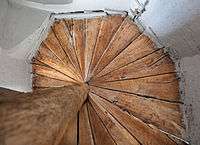Institute of Continuing Education

The Institute of Continuing Education (ICE) is a constituent part of the University of Cambridge. The institute encourages people in all walks of life to take advantage of continuing education.
Offerings, students, and staff
ICE offers residential, online, weekend, summer, and part-time courses, as well as public lectures.[1] The Institute also provides free public concerts performed by Cambridge musicians, featuring new student work alongside more traditional repertoire.[2][3]
The Institute has an enrollment of over 6,000 students and has an academic staff of 13. A summer program brings in another 1,000 students from over 60 countries.[1] The academic staff are called "lecturers", and the Institute's teaching is also accomplished by a group of about 300 "tutors" located in the Cambridge area and elsewhere.[1][4]
ICE offers course credits via the United Kingdom's Credit Accumulation and Transfer Scheme, and those credits may be transferable to other Cambridge degree programs, and to other U.K. and U.S. universities.[5] The duration of study varies, from one and two-day courses, through two-year part-time master's degrees, and courses are often taken for personal interest or for professional development.[1]
Headquarters and history
The Institute's headquarters is in the village of Madingley, Cambridgeshire. It is housed in Madingley Hall, about four miles west of the Cambridge city limits.[5] Madingley Hall was built in the 1540s and was later rented by Queen Victoria for the young Prince of Wales (later Edward VII) while he was a student at Cambridge.[1][5][6]
ICE moved to Madingley Hall in 1975,[1] but has been educating part-time and adult students since the 1860s.[5] It is the oldest continuing education department in the United Kingdom.[1]
The founder of ICE was University of Cambridge scientist James Stuart.[4][7] In 1867, Stuart gave a course of lectures in various cities, which marked the beginning of the university extension movement. The University of Cambridge sanctioned the movement a few years later, in 1873, with the first course offered in Derby that year.[8]
Supervision by university
In 2008, when Cambridge University indirectly offered its stamp of approval for certificates in things like "garden history" and "creative writing", the university faced accusations of dumbing down.[9] According to The Daily Telegraph, the university decided to, "take over the awarding of certificates currently offered by bodies such as the Cambridge Institute of Continuing Education….”[9]
Today, the work of ICE is controlled by the General Board of the University, through a management committee. The institute's lecturers are all appointed by the University.[4]
See also
References
- 1 2 3 4 5 6 7 Care, Adam (October 24, 2014). "You're never too old for a Cambridge education". Cambridge News. Retrieved June 13, 2015.
- ↑ "Ghislaine McMullin plays Russian cello music”, Cambridge News (February 18, 2015).
- ↑ “University of Cambridge Institute of Continuing Education: Welcome to the Madingley Concerts”, Accessed June 17, 2015; “University of Cambridge Institute of Continuing Education: What We Do”, Accessed June 17, 2015.
- 1 2 3 Barlow, Adrian. Extramural: Literature and Lifelong Learning, pp. 18-19. (Lutterworth Press 2012).
- 1 2 3 4 Henderson, C.W. Open the Gates to the Ivy League: A Plan B for Getting into the Top Colleges, p. 87 (Penguin 2013).
- ↑ Care, Adam (April 23, 2015). "More than 380 species discovered at Cambridge University's Madingley Hall". Cambridge News. Retrieved June 13, 2015.
- ↑ "Institute of Continuing Education to sponsor Team of the Year prize at News' Junior Sports Award", Cambridge News (May 15, 2015).
- ↑ Jarvis, Peter. Adult Education and Lifelong Learning: Theory and Practice, p. 318 (Routledge 2004).
- 1 2 Bingham, John. "Garden history and 'wellbeing' qualifications from Cambridge University”, The Daily Telegraph (December 22, 2008).



